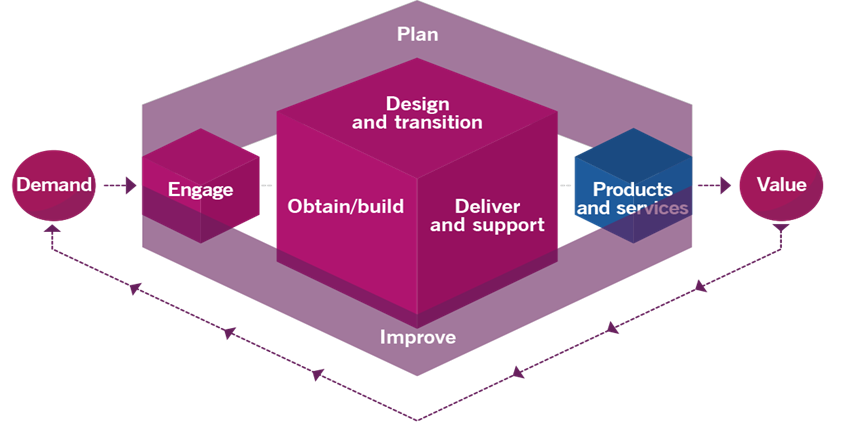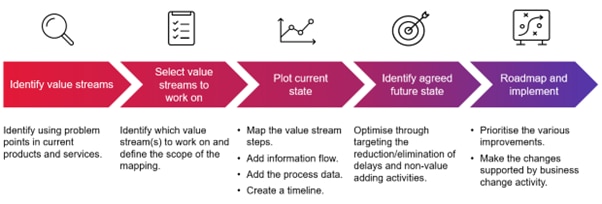When ITIL 4® introduced its Service Value Chain (SVC) operating model, we were told it would turbocharge service improvements and make them more relevant to our customers in an increasingly complex and agile world.
However, the SVC left many service management purists a little bewildered. Value chains, processes and practices - it all seemed too complex! Mistakes were made and confusion reigned as we struggled to identify value chains in an effort to implement process improvements; investigations became far too detailed and the wrong people were often involved in what became a value stream maelstrom.
Despite this, we believe that with a better understanding of ITIL®’s adopt and adapt mantra, applying value streams can offer you a clear path to service improvement.
What is the Service Value Chain?
The SVC is ITIL®’s operating model which outlines the key activities required to respond to demand and facilitate value realisation through the creation and management of products and services.
Figure 1: The Service Value Chain - Copyright © AXELOS Limited 2022. Reproduced under licence from AXELOS Limited. All rights reserved.
The model follows traditional value stream logic by starting with the customer’s demand and ending with creating value for the customer. From a service management perspective, we can interpret “customers” as being internal or external, and the value streams will either run the business, grow the business, or transform/change the business by passing through the components of the SVC.
It is critical to remember that service management value streams are typically more complex than just one process. For example, a “restore the service” value stream could easily involve inputs and processing from people and processes beyond simple incident management, such as problem, change, configuration and event monitoring.
How do we use the SVC?
The beauty of the SVC is it can be used to improve your service and add value almost entirely divorced from the processes, practices or methods you use to support it. It’s just as easy to adapt and use this value chain technique if you are deploying Site Reliability Engineering, IT4IT or ITIL® in any of its four iterations.
Let’s illustrate this with the example of updating an application. Whether it is delivered through an Agile Release Train, DevOps or more traditional methods, it will still be recorded (engage, above), approved (plan), designed (design/transition), coded (obtain/build), transitioned (design/transition) and supported (deliver/support). Again, these processes are all targeted at adding value to the customer.
At CGI, the universal appeal of the SVC method has therefore been used by our Advisory Services team to deliver huge benefits to both IT and non-IT value streams for our clients, including one of the UK’s biggest discount retailers.
Adopt the principles
If the SVC is to successfully enable service improvement, you must first adopt some guiding principles.
- Collaborate – Including the right team members is important. This requires both those who know the intricacies of the current value streams, and critically those who can authorise changes. Without their presence and buy-in, your efforts simply become a talking shop.
- Value – To understand the value we must talk to the customer and understand their perspective. Since the whole process is geared towards customer value, failure to achieve this is a fatal flaw.
- Scoping - It is critical to scope appropriately. Attempting to map everything will result in the team getting lost in the detail, and analysis paralysis makes it easy to miss critical improvement opportunities and solutions.
- Iteration – It is almost always better to follow an iterative approach to changes to avoid too much disruption. A big bang re-engineering of a process risks a regression in the value delivered to the customer.
Adapt the process
The CGI approach to value stream mapping is straightforward:
- Start by identifying your value streams - take care to not make them too complex!
- Choose which ones you will work on, remembering to include those people who can actually make the decisions on changes.
- Plot the current value stream – that’s what you actually do, not what you think you should do according to your process documents.
- Optimisation towards your future state – that means identifying and removing waste such as duplicate work, defects or unnecessary steps, but remembering that some waste may be necessary, such as creating documents for mandatory regulation.
- Finally, realise the value by producing a roadmap and implementing the changes with support from mandatory business and organisational change elements.
Figure 2: Our approach to service management value stream mapping.
Let’s work together
For over 45 years, organisations have trusted CGI to transform their operations with innovative and reliable services and solutions. Committed to supporting our clients for every step of their digital journeys, we established our Advisory Services, where our experts use their knowledge and experience of delivering world-class IT to collaborate closely with clients and help them unlock their full potential.
With service excellence more vital than ever, we can use our experience to create value, optimise and improve your services. We will help you understand the value streams, processes and practices that are delivering outcomes within your organisation to make your transformation initiatives a success.
If you’d like to discuss how we can help realise your value, please reach out to me. Or for more information generally about how we can support your customer-focused digital transformation ambitions, explore our Digital Backbone methodology.








